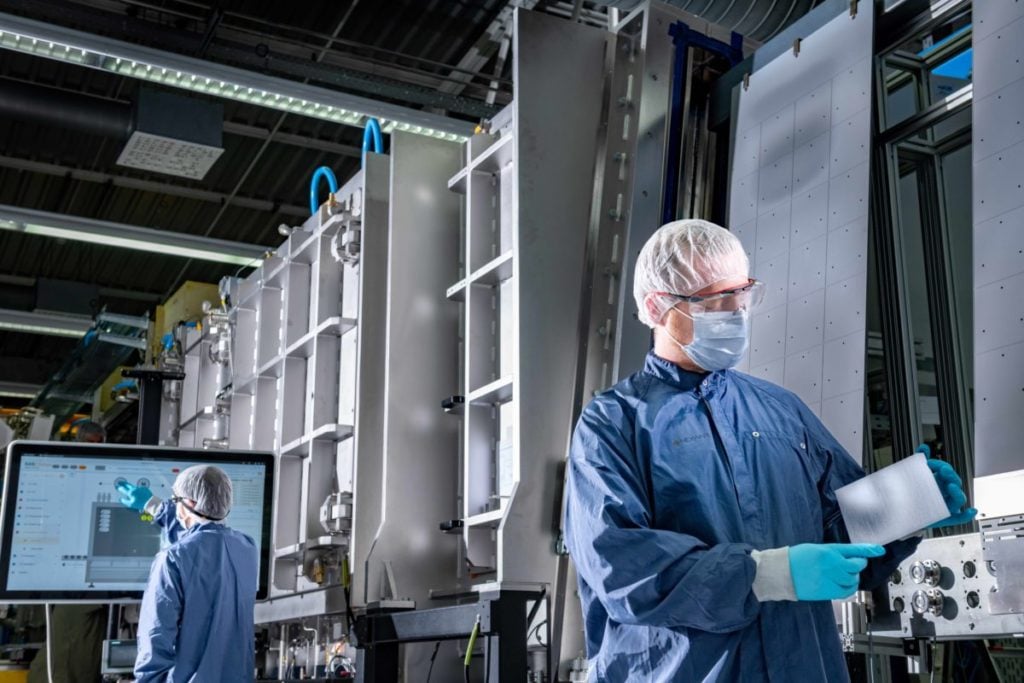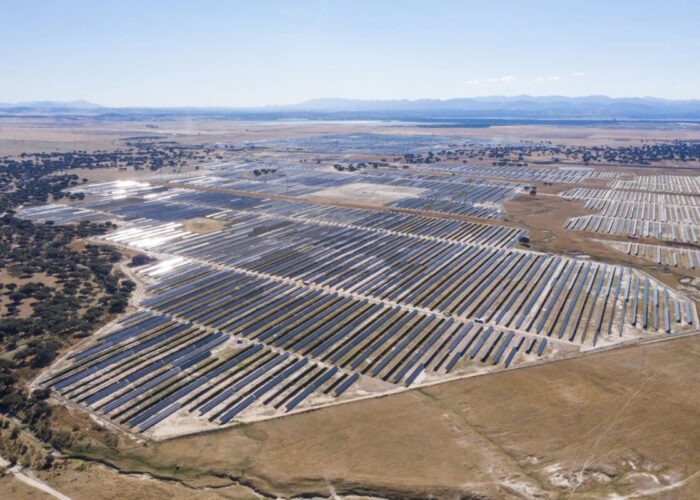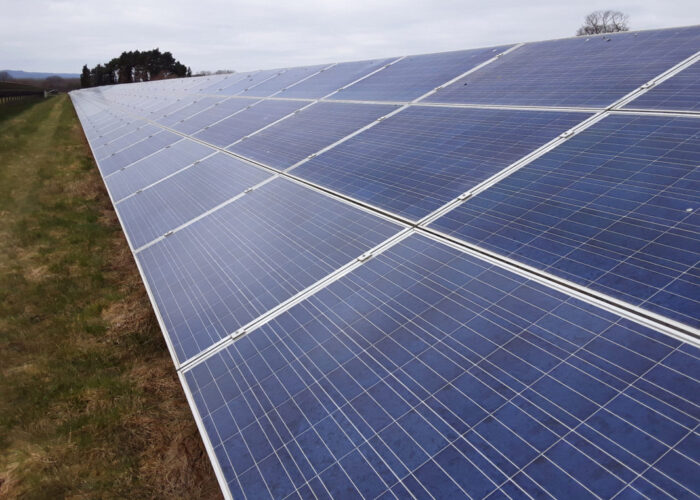
Headlines in the media in recent weeks and months regarding the plight of the European PV industry have not made for pleasant reading. However, the situation is far from bleak for companies and research institutes across Europe today.
European companies play on the global stage, not simply to help Europe have its own ecosystem for PV that is decoupled from the rest of the world.
Unlock unlimited access for 12 whole months of distinctive global analysis
Photovoltaics International is now included.
- Regular insight and analysis of the industry’s biggest developments
- In-depth interviews with the industry’s leading figures
- Unlimited digital access to the PV Tech Power journal catalogue
- Unlimited digital access to the Photovoltaics International journal catalogue
- Access to more than 1,000 technical papers
- Discounts on Solar Media’s portfolio of events, in-person and virtual
Simply put, the proposition for PV companies and research institutes in Europe is as international entities, and fortunately, new opportunities have emerged recently that should allow many PV companies in Europe to carve out differentiated business models as the industry moves to terawatt annual production levels over the coming years with a growing diversification of supply chains.
With the PV CellTech Europe 2024 conference taking place in Frankfurt, Germany, on 12-13 March 2024, we have decided to highlight some of the most exciting PV activity in Europe at the event and how this is relevant within an evolving global context.
This should explain why Europe matters today in the PV industry – possibly more than in the past when the region had a scattering of cell and module makers (serving a small subsidised rooftop sector) and equipment suppliers beholden to selling into China.
This article explains what has changed in the past few years to create these new opportunities for European PV companies and how PV CellTech Europe 2024 will provide a constructive forum to plan for the future: almost the polar opposite of the media-infused malaise of the past few months.
The demise of European PV manufacturing is not a new phenomenon
Let’s get one thing straight. European PV manufacturing was decimated more than a decade ago. This is not a new phenomenon that has come about from the oversupply of Chinese modules in Europe in the past 12 months.
Europe had a fledgling PV manufacturing sector 20 years ago; a time when the global installed volumes were measured in the gigawatt range, and when demand was heavily subsidised by incentives in countries such as Japan, Spain, Italy and Germany.
When China entered the sector with a bang back in 2010-2013, the focus was shipping modules out of China, mainly to Europe. The 2013 surge in shipments – just as various incentives were scaled back or stopped altogether – was the final nail in the coffin for European manufacturing. The last bastion of the Made-in-Germany mantra, SolarWorld, put up a valiant fight but eventually succumbed to the sheer weight of China that now had the only solution to Europe’s pending shift to capital expenditures (capex)-squeezed, post-subsidy solar farm growth.
For the past decade, PV manufacturing in Europe has been almost non-existent. Many of the companies that previously made (or distributed) modules in Europe set up strategic partnerships with module producers in China; either relabelling their products or having arrangements to be the overseas brand for export sales out of China.
Companies that were actually making modules in Europe could almost be counted on one hand. Making wafers and cells was no longer a meaningful proposition. Only Wacker Chemie could be counted as a major producer (of polysilicon) in the region.
Green shoots for global growth
In recent years, the most meaningful capacity build-out – within the broader European scope – has been in Turkey, where original equipment manufacturer (OEM) arrangements with Chinese module suppliers (active in Europe and the US) have created strong opportunities.
Technology change in the sector has also been the foundation for ongoing capacity investments by Meyer Burger and 3Sun (Enel). For these companies, the sales opportunity is not driven by having a purely domestic business focus, but by having the right product (in each case, heterojunction cell and module manufacturing) for the right end-market (most significantly, the US market).
Various other plans for manufacturing have been mooted in Europe that may or may not come to fruition. One of the credible propositions in this regard today is CARBON, with plans for multi-GW scale cell and module manufacturing in France.
For all of these companies, it is perhaps the growing demand for non-Chinese owned or operated module supply globally that is the big driver. Today, the US is by far the main pull, but the world is full of corporate buyers that have their own sustainability or traceability purchasing decision-making and project pipelines that are truly international in nature; buying modules from Europe (or Turkey) under framework contracts that could see the modules being installed in, for example, the US, Europe or Latin America.
Also, PV production equipment and materials suppliers with facilities in Europe are seeing an uptick in order activity. Not from within Europe necessarily, but in other countries that are further along the curve in terms of building up a domestic PV ecosystem; in particular, India and the US.
India is perhaps the country with the most short-term opportunities for European equipment producers. This is being driven by the new wave of cell production line additions. Over the past decade, most of the equipment spending out of India has been for module assembly factories, with almost all of the orders being placed on Chinese turn-key line suppliers (and a huge amount to just one company from China).
India is now seeking to diversify its equipment buying for cell capacity build-outs, and there remains a very pro-Europe/pro-Germany aspect to Indian PV companies when it comes to cell equipment and technology leadership.
The situation for cell capacity additions in the US is very similar to India, but with a time lag and some additional policy questions that need to be overcome first (for example, incentivising capex not operating expenses (opex). This year, module line additions are the name of the game in the US, but there is no shortage of plans for cell lines coming to fruition, the first of note almost certainly being Hanwha Qcells.
Activity in India and the US is key to PV equipment suppliers in Europe today, and one can only hope that the investor landscape in Europe will have changed in a few years to allow Europe to benefit from successes to diversify cell and module capacity elsewhere.
The final category to consider within this context is research institutes in Europe, many of whom remain at the forefront of research and development and technology-transfer. Similar to PV equipment suppliers, this grouping also has a key part to play in the growing number of cell lines in India and the US, in many cases with companies that are either new to PV manufacturing or that have been active only in module assembly.
As such, while much of the media coverage has centred on the challenges of creating a fully resilient supply chain for PV manufacturing, it is the global stage that offers the best chances for Europe-based PV companies over the next few years. Not simply plugging gaps created by China, but through differentiation in technology and component traceability (now top of the list in module buying preferences outside China).
PV CellTech Europe 2024 in Frankfurt on 12-13 March 2024
The European edition of the PV CellTech conference series remains PV Tech’s flagship event globally to fully understand industry technology adoption and roadmap advancement: regardless of the place of manufacturing or the companies fueling the 500-GW-plus of silicon-based components manufactured this year.
Over the two days of PV CellTech Europe 2024, almost all global technology leaders in the PV sector will be speaking about mass production trends for 2024 and 2025.
The full agenda can be viewed on the PV CellTech Europe 2024 website, here.
Here is a quick walk through some of the main speakers and session topics.
Leading cell producers from China (many of whom have manufacturing capacity today also in Southeast Asia) include Tongwei, Jinko Solar, Trina Solar, Runergy, Huasun, Risen and Astronergy.
The inclusion of Tongwei is a key draw to PV CellTech once again, as the company is the biggest producer of solar cells globally today (not to mention the biggest producer of polysilicon globally also).
Jinko Solar’s part in being the catalyst in moving almost the entire sector from p-type monocrystalline passivation emitter rear contact cell (p-mono PERC) to Tunnel Oxide Passivated Contact (TOPCon) as the mainstream technology offering in 2024, cannot be underestimated; knowing how Jinko is moving TOPCon to its next-generation iterations is hugely important for everyone to understand.
Trina Solar remains one of the most technically advanced cell producers globally, leveraging huge investments into R&D in the past decade, much of this with n-type architectures. Indeed, as the industry starts to adopt more back-contact cells in the coming years, Trina’s R&D work here may end up being highly beneficial.
Huasun and Risen are currently the two leading producers globally for heterojunction (HJT) cells, with Huasun being the current leader in this regard. These two companies are the first to reach multi-GW of HJT cell capacity in mass production. Learning about production line yields, fleet efficiency levels, and manufacturing cost roadmaps is critical to how HJT activity grows now globally.
Astronergy’s investments in cell and module capacity in the past few years have been incredible. The company has been active in the PV industry for many years, but has been transformed recently into a company set to make north of 30GW this year. How the company chooses its cell technology roadmap is now something that will have a key impact overall.
Rounding out this contingent of Chinese cell producers is Runergy. Again, Runergy’s transformation in the past three years has been astonishing. Previously a somewhat unknown pure-play cell maker in China (and one of the leading ones then), the company has exploded onto the global stage. Runergy is now only one of very few PV manufacturers to have full value-chain in-house production capability (polysilicon, ingot, wafer, cell and module), is probably the leading cell producer now in Southeast Asia, and is well entrenched in global module sales activity (including the key overseas market in the US).
As one of the few companies globally with a truly international footprint, Hanwha Qcells returns again to PV CellTech. These days, Qcells globally is making some of the largest PV manufacturing investments seen ever in the Western world, with the current built-out of multi-GW n-type capacity in the US typifying this long-term commitment to manufacturing. New ingot/wafer and cell/module lines are almost ready to come online in the US, likely to make Qcells the most vertically integrated silicon-based company making products in the US.
Fully aligned with the new opportunities for PV equipment suppliers today, PV CellTech Europe 2024 will see more representation from the equipment supply chain than at any time before. The companies are dominated by European entities but also include leading tool suppliers in Asia and the US.
The list of equipment companies speaking and participating at the conference includes Applied Materials, ECM Greentech, Exateq, Halm, Maxwell, Mondragon, PVA TePla, Rena, Singulus, Vitronic and Von Ardenne.
During the event, there will also be contributions from some of the existing and new manufacturers across Europe, including Wacker Chemie, NexWafe, CARBON, Oxford PV, 3Sun and Futurasun. Leading research institutes will also be presenting: CEA-INES, Fraunhofer-ISE, Forschungszentrum Jülich, and ISC Konstanz.
Across the two days, market-based information will be delivered by Bernreuter Research, the VDMA, the ESMC and – as is customary at PV CellTech – my talks on PV Tech market research findings. A special feature will be the first overview of the ITRPV Roadmap, now in its 15th year.
Getting involved in PV CellTech Europe 2024
The agenda is almost full, with just a couple of slots still to be finalised. Otherwise, attendance is certainly welcomed. Recently, the event has been seeing an increasing number of downstream developers and investors come to learn more about technology, and we expect this to be a feature again this year.
Now in its ninth year, PV CellTech has become the PV industry’s flagship event to understand technology in manufacturing and how this will evolve in the next few years. The event in Frankfurt on 12-13 March 2024 looks set to continue this proud tradition.







